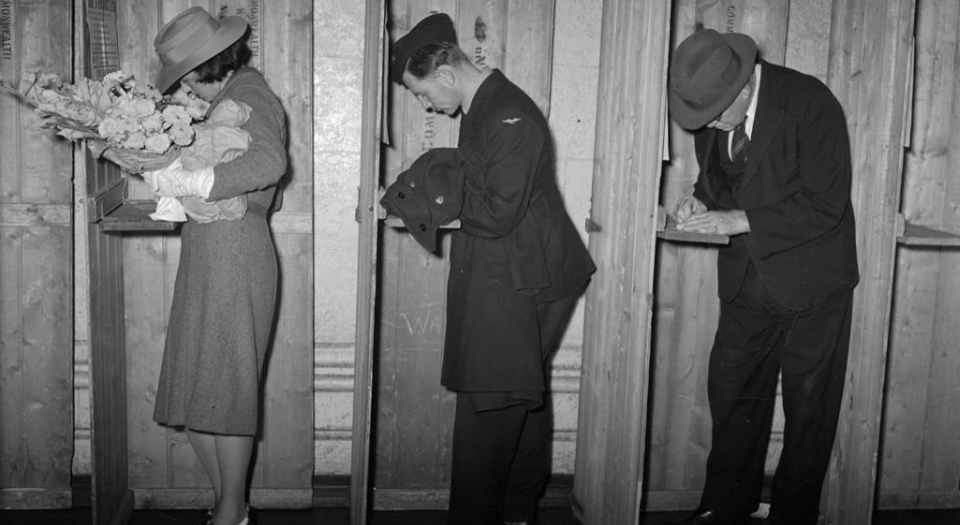
Long-read
Electoral fatigue syndrome
David Van Reybrouck’s Against Elections fails to acknowledge that there's more to politics than the drawing of lots.
We have a problem with democracy in the 21st century. Everyone agrees that democracy is a good thing, but no one seems to believe in it anymore. So begins Against Elections, David Van Reybrouck’s 2013 book, published in English in 2016.
Van Reybrouck explores the apparent crisis of democracy though the metaphor of disease, describing the symptoms, diagnoses and pathogenesis of what he terms ‘democratic fatigue syndrome’ (DFS). He evokes an image of democracy lying critically ill, perhaps on its deathbed.
Where others have seen voter apathy, Van Reybrouck sees people frustrated by the vast gulf between what they want and what they see politicians doing. They don’t feel as if their vote will make a difference. Hence, across most Western countries over the past 20 to 30 years, voter turnout has declined, membership of political parties and trade unions has decreased, and voter loyalty to parties has withered. Floating voters have become the norm.
Van Reybrouck runs through a selection of common diagnoses for DFS. Some suggest it’s because politicians are a distant and corrupt class that has lost touch with ordinary people. Some blame democracy itself, arguing that democratically elected governments are too constrained by the democratic system ever really to get things done. Others say it’s the fault of party politics. After all, when politicians seem to devote all their energy to power struggles between (or even within) parties, then to what extent are they really representing the people?
Van Reybrouck rejects these common diagnoses, pointing out that the solutions they promise are all dangerous. Instead he argues that the real problem is electoral representative democracy itself.
As he explains, it is only over the past 200 years that elections have become the main mechanism of democracy. Hitherto, societies that experimented with democracy tended to rely on the drawing of lots, known as sortition. As Van Reybrouck notes, the drawing of lot was the principal way in which public roles were filled in the birthplace of democracy, Ancient Athens. During the Enlightenment, many thinkers still considered the drawing of lots to be the most democratic form of government. As Montesquieu put it in The Spirit of the Laws (1748), ‘Voting by lot is in the nature of democracy; voting by choice is in the nature of aristocracy’. Rousseau, agreed, arguing that public positions requiring men of talent ought to be filled by election while positions that required ‘good sense, justice, and integrity’ could be filled by the use of lots.
It was only after the American and French revolutions that elections became the accepted mechanism of a democratic society. Van Reybrouck argues that this shift in thinking was not as radical some assume. Above and beyond the practical difficulties of governing through sortition at a time when no one really had a record of who lived where, Van Reybrouck argues that there was a political reason for post-revolutionary elites to favour elections: they did not really want rule by the people. Rather, they were concerned that the ‘best’ should rule. As American revolutionary John Adams wrote in his Thoughts on Government (1776), elections allowed rulers to ‘depute power from the many, to a few of the most wise and good’. And again, as the French constitution had it in 1791, ‘The nation, from which alone all powers emanate, may exercise such powers only by delegation. The French Constitution is representative.’ This ‘aristocratisation of the revolution’, as Van Reybrouck puts it, meant that the revolutions merely replaced a hereditary aristocracy with an elected aristocracy.
Since the age of revolution, there have been several significant political and electoral changes: political parties emerged after 1850; universal suffrage emerged in the early 20th century; and the growth of organised civil society following the Second World War led to a period when the interests of large sections of society were represented and channelled through collective institutions such as trade unions and mass political parties. But, as Van Reybrouck tells it, the relative stability of the postwar years was brought to an end in the 1990s with the rise of neoliberal thinking, and the increasing role of commercial media in the public arena. Party newspapers and government-owned media were displaced by mass commercial media, and citizens were reshaped as consumers. Governments spoke directly to people through the media rather than through intermediaries such as trade unions and other collective institutions. And now social media have further crowded the political scene.
This history is instructive, acting as a reminder that our current electoral system is just one part of a long period of experimentation with different forms of democracy. However, as useful as this historical overview is, Van Reybrouck seems to cherry-pick his examples. This leads him to highlight the use of lots in Ancient Athens, while downplaying the role elections played there. He draws attention to the more dubious reasons for introducing elections following the American and French revolutions, but largely ignores the huge social and political gains made during this period. Importantly, his focus on the role of the media, and especially social media, in more recent years, leads him to downplay the end of the Cold War, the collapse of competing ideologies, and the resulting emptying out of much of the content of politics. And yet it is perhaps this post-Cold War emptying out of politics as much as the other trends he describes, that reduced politics to means rather than ends.
A further implication of this impoverished version of politics after the end of the Cold War is that the meaning of representation changes. The importance of the American and French revolutions, and the ideas that flowed from them, was that they brought into sharp relief the fact that different groups in society have distinct interests, which are often in conflict with each other. The idea that the ruling capitalist class has interests that are in direct conflict with the interests of workers was made increasingly more explicit. Political representation was about having these interests represented in the political sphere. More abstractly, competing visions of what society should look like – ideas that arose through argument and debate – were represented by individual politicians and parties, and people could choose to vote for the person whose vision most closely aligned with their own. However, in the absence of political vision, the meaning of representation becomes degraded. It is less to do with ideas, than with demography: gender, ethnicity, social class and so on. Are political decision-makers representative of the population? Is there a 50:50 gender split? Are minority ethnic groups represented? And so on. In this context, no wonder the drawing of lots makes as much sense to Van Reybrouck as persisting with electoral democracy.
Van Reybrouck attempts to show how sortition could be incorporated into our political system. He describes recent experiments in consultation and deliberative democracy that have used sortition, such as the drawing up of new constitutions in Iceland and Ireland, and attempts to reform the electoral system in Canada and the Netherlands. These experiments have involved selecting members of the public through sortition, giving them specific questions to deliberate on, and then managing the process in a way that they can deliberate over questions for nine to 12 months.
There are both strengths and weaknesses to this process. As Alexis de Tocqueville commented in Democracy in America (1835), engaging in public service in this way obliges people to turn their attention to affairs that are not their own and increases their understanding of the issues and their ability to reason about them. De Tocqueville went further and argued that one effect of jury service is that the ‘spirit of the judges’ – knowledge of the legal system, due process, and so on – is communicated to the people through jury service, which lays a sound basis for free institutions. Van Reybrouck points out that the reports produced by the recent citizen-parliaments present nuanced arguments about constitutional and electoral reform, challenging the idea that ordinary people cannot understand complex issues.
However, these experiments in sortition have had variable success; the results have not always been binding, have sometimes simply been ignored by elected politicians, and overall seem to have had little real influence. Moreover, the questions people were allowed to deliberate on were usually decided by politicians in advance, and the process stage-managed by the current political establishment. It is debateable whether the driving force behind these experiments was truly to enable the public to shape the future through a new form of government, or to lend legitimacy to an existing political establishment.
Van Reybrouck presents various proposals for systems involving sortition, including a detailed plan by the American researcher Terrill ‘Terry’ Bouricius for multi-body sortition. This system would involve six different bodies chosen by sortition that would carry out all functions of government, from proposing and compiling legislation, to voting on it, and overseeing and regulating the process. It is a bold, refreshing proposal that shows great trust in the potential of ordinary people to understand complex political issues and, ultimately, to govern.
However, through attempting to strip out what Van Reybrouck might think are the worst excesses of the parliamentary system he ends up fundamentally undermining what politics should be about. Hence passion and vision are very deliberately stripped out from the process of debate and decision-making in favour of a strictly rational evaluation of the evidence. It is not clear to what extent those participating would hear from sources in wider society or if they would only be presented with certain, sanctioned evidence sources.
The limitations of the analogy with jury service must also be made clear. Criminal trials are about establishing what has happened in the past so as to make a judgement about someone’s guilt or innocence. This necessarily limits the jury’s deliberation to a narrow consideration of the facts. However, politics is about imagining and working out what sort of world we want to live in in the future. There is not a ‘right’ and ‘wrong’ answer that can be arrived at through deliberation with experts; rather, people must present competing visions and seek to convince others that theirs is a vision worth pursuing.
While this book makes some useful explanatory inroads into the phenomenon of DFS, it unfortunately ends up falling into many of the same traps that others do. So Van Reybrouck criticises those who see the problem as one of process and personality and who propose solutions that focus on the means of democracy rather than the ends, but then takes the same approach himself. The sortitive system that Van Reybrouck thinks would reinvigorate democracy actually formalises the managerial trajectory of contemporary politics that so disillusions the public.
This is a fundamental reimagining of what politics should be. While removing the influence of parties and interest groups might sound tempting in an age when these groups often seem to be a bit grubby, it is worth considering what this means. Groups in society whose interests are in conflict with each other would no longer have the space to organise themselves and ensure that their interests are represented. The model put forward by Van Reybrouck rests on the assumption that everyone has broadly the same interests and the best way to implement those will be arrived at through the consensus of a representative sample of the population. This might have worked in Ancient Athens, when the citizens consisted of a very narrow section of society whose interests would have been broadly the same, but it does not necessarily work when competing groups are part of the same process. It is interesting to imagine how sortition might have worked in Athens if women and slaves were included.
Ultimately, while Van Reybrouck criticises others for taking the approach of ‘politics as civic engineering, problem-management’, he then proposes another system that is about changing the means rather than reinvigorating debate about what the ends should be. Because that is key: the solution to our democratic disenchantment must involve reinvigorating debate about what sort of world we want to live in as well as imagining how we might be able to get there.
Fiona McEwen is a postdoctoral researcher in psychology at Queen Mary University of London.
Against Elections: The Case for Democracy, by David Van Reybrouck, is published by Bodley Head. (Buy this book from Amazon(UK)).
Picture by: State Library of WA, published under a creative commons licence.
To enquire about republishing spiked’s content, a right to reply or to request a correction, please contact the managing editor, Viv Regan.







Comments
Want to join the conversation?
Only spiked supporters and patrons, who donate regularly to us, can comment on our articles.